Spanish scientists participate in a revolutionary project to detect heart failure
Monday, February 26, 2018
Researchers from the Spanish National Research Council (CSIC) are participating in a major international project, funded by the European Commission, to develop a portable device, that will detect heart failure from saliva samples. The project, called “KardiaTooly platform”, will allow a quick, easy and efficient diagnosis, and personalised and improved health care for patients suffering from heart failure.
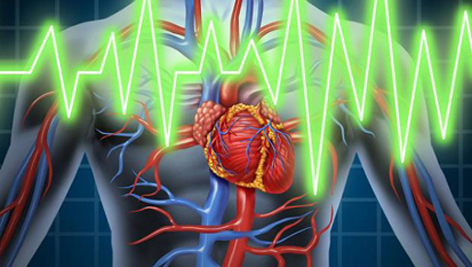
Heart failure
The “KardiaTool platform” will include a portable device, KardiaPOC (POC for point of care), to quickly and accurately detect the biomarkers of heart failure. It will be coupled with the KardiaLOC device, a low-cost, single-use laboratory-on-a-chip that will integrate sensors, actuators, microelectromechanical and microelectronic systems, biochemicals, and functionalised magnetic nanoparticles, to detect biomarkers from samples of saliva.
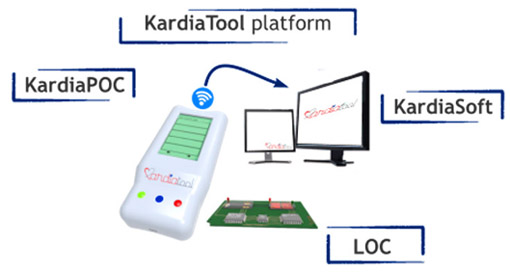
Kardia Tool

Test made with saliva
The team of the researcher Joan Bausells, from the Institute of Microelectronics of Barcelona (IMB-CNM), will work on the microelectronic silicon sensors that will detect the biomarkers, and will collaborate in the design of the KardiaLOC. On the other hand, the researcher Francesc Teixidor and his team at the Institute of Materials Science of Barcelona (ICMAB) will work on the synthesis and functionalization of magnetic nanoparticles, which will constitute the support for specific antibodies for each biomarker.

Joan Bausells
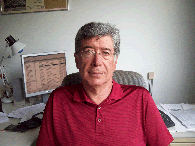
Francesc Teixidor
In addition, the device will also include a software as a support for tooking decisions, named “KardiaSoft”, based on prediction model techniques, which will analyse the data collected in the KardiaPOC, and other patient data, in order to provide information on the diagnosis and the monitoring of therapy.
KardiaTool groups the participation of fourteen partners from nine European countries and the United States. The consortium consists of five universities, five research centers, two small and medium-sized companies, and two industrial partners.
The members of the consortium of the “KardiaTool” project are: the Normal Higher School of Lyon (France), the University of Pisa (Italy), the Ioannina University (Greece), the University of Surrey (United Kingdom), the University College of Dublin (Ireland) ), the Greek Foundation for Research and Technology (Greece), the National Research Council (Italy), the Fraunhofer Institute for Integrated Circuits (Germany), Micron Microtechnologies (The Netherlands), BioTray (France), Imec (Belgium), ValoTec (France), EnaChip (USA), and the Institute of Materials Science of Barcelona (ICMAB) and the Microelectronics Institute of Barcelona-National Center for Microelectronics (IMB-CNM).
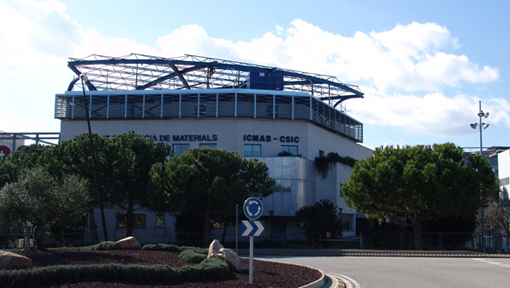
ICMAB
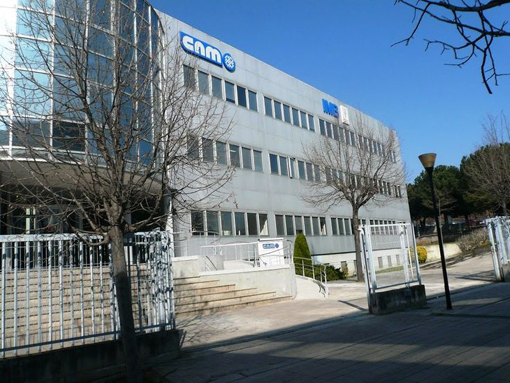
IMB
Well, I hope the you will do like this article such as I do.
Until my next post, kind regards,
Luis.
Sponsored by Costaluz Lawyers
Please click below:

 0
Like
Published at 10:08 AM Comments (0)
0
Like
Published at 10:08 AM Comments (0)
Homemade food for office in southern Spain
Thursday, February 22, 2018
Today I would like to talk to you about a very interesting project, started by a young and courageous woman, from Asturias, called Marian Cienfuegos, 4 years ago. She called her business project "Comeveydile" (“Eatgoandtellit”) --doing a simile of the famous expression "Correveydile"(“Rungoandtellit”), which refers to the gossip person--.
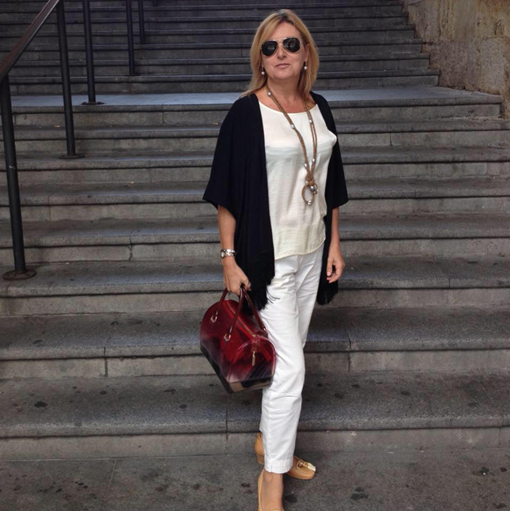
Photo of Marian Cienfuegos in Facebook
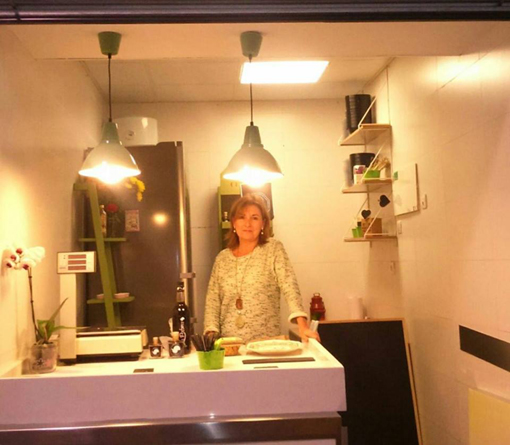
Marian
Marian is the first person, who creates a company, to serve homemade food to the offices, in Malaga.
She cooks different Menus, from Monday to Friday, and you can find different types of Menus, each day. You can choose a menu for 5,50 Euros. And delivery is free. I am going to show you several Menus with some dishes:
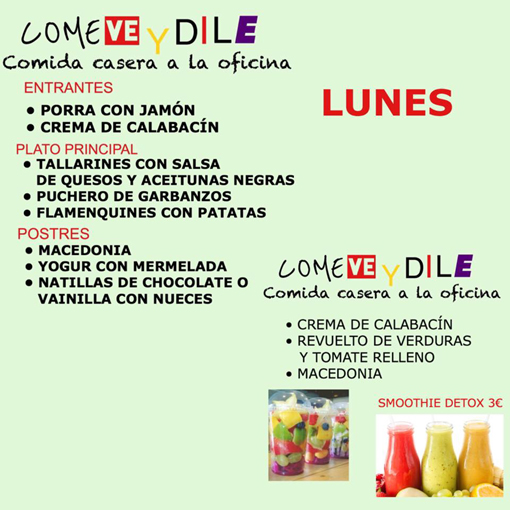
Menu with Puchero de garbanzos and Macedonia on Monday
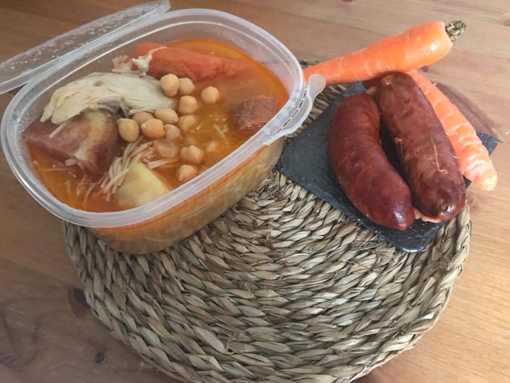
Puchero de garbanzos = Chickpea stew
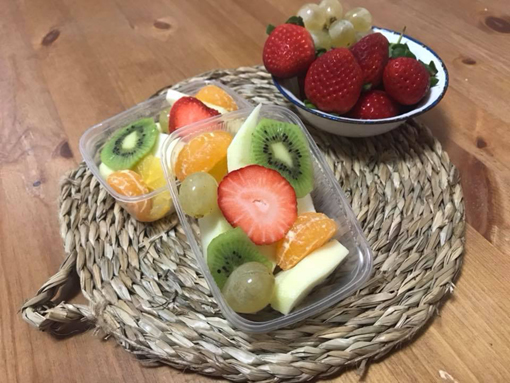
Macedonia de frutas = Fruit salad
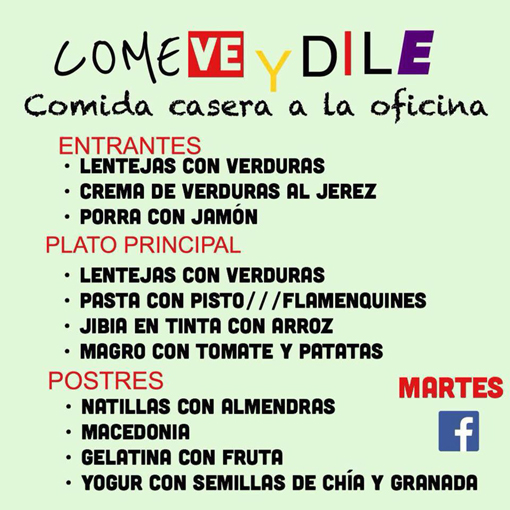
Menu with Lentejas con verduras on Tuesday
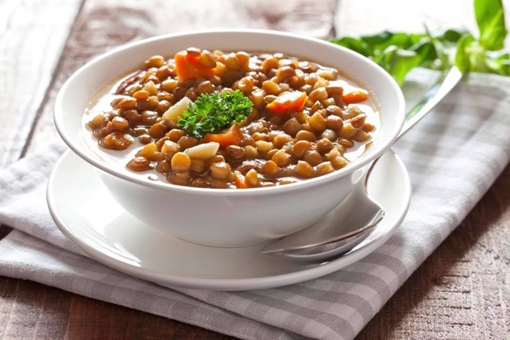
Lentejas con verduras = Lentils with Vegetables on Tuesday
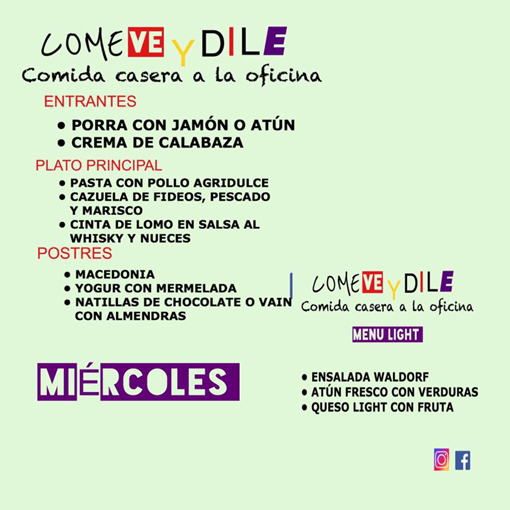
Menu with Cinta de lomo en salsa al whisky y nueces on Wenesday
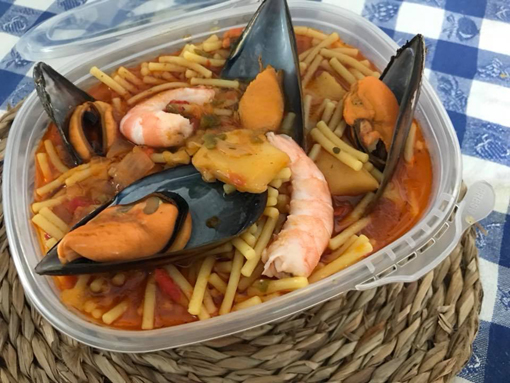
Cazuela de fideos, pescado y marisco = Casserole of noodles, fish and seafood
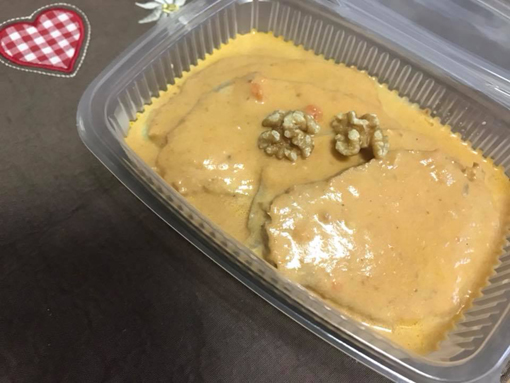
Cinta de lomo en salsa al whisky y nueces = Loin tape in whiskey sauce and nuts on Wenesday
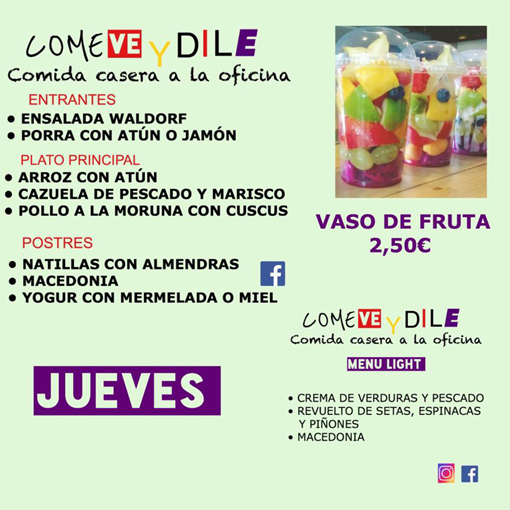
Menu with Porra con atun o jamon y Arroz con atun on Thursday
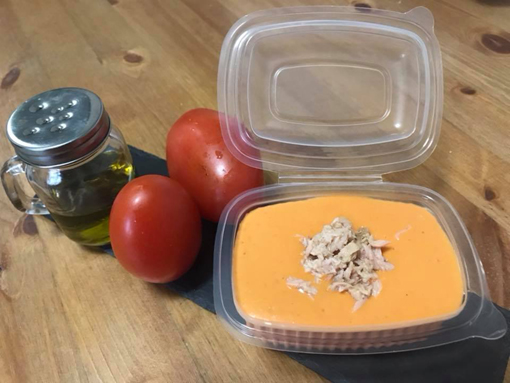
Porra con atun = Porra with tuna

Arroz con atun = Rice with tuna
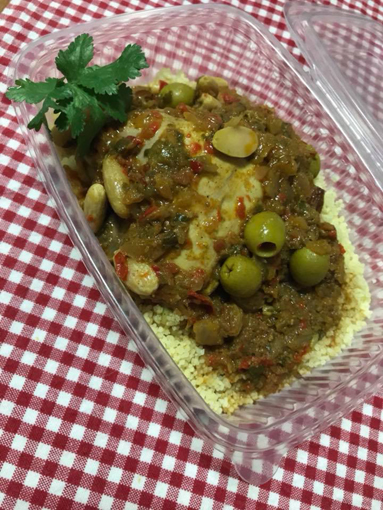
Pollo a la moruna = Chicken on moorish style
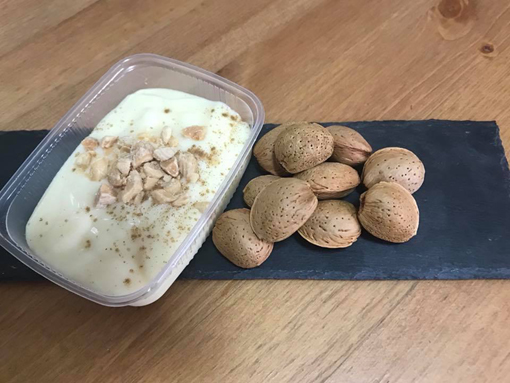
Natillas con huevo y almendras = Custard with egg and almonds
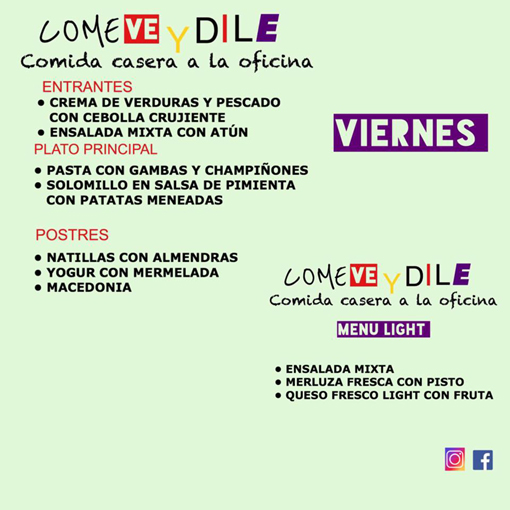
Menu with crema de pescado y verduras on Friday
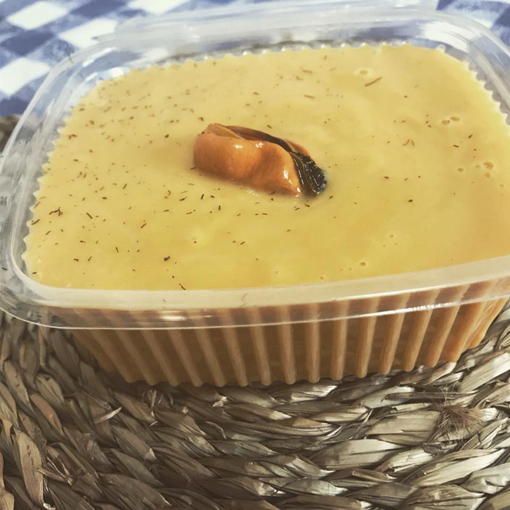
Crema de pescado y verduras = Cream of fish and vegetables on Friday
But you can taste another Menu on Friday:
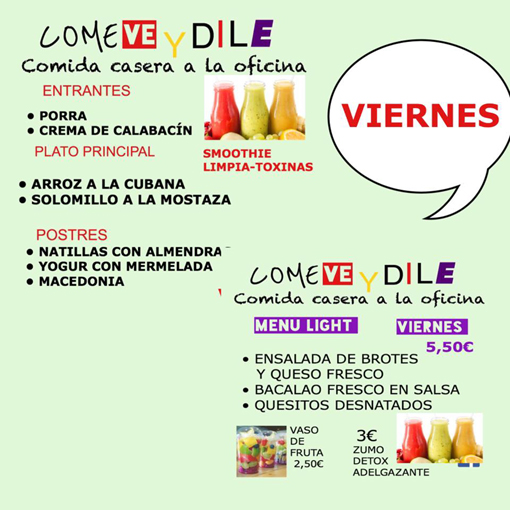
Menu with Solomillo a la mostaza on Friday
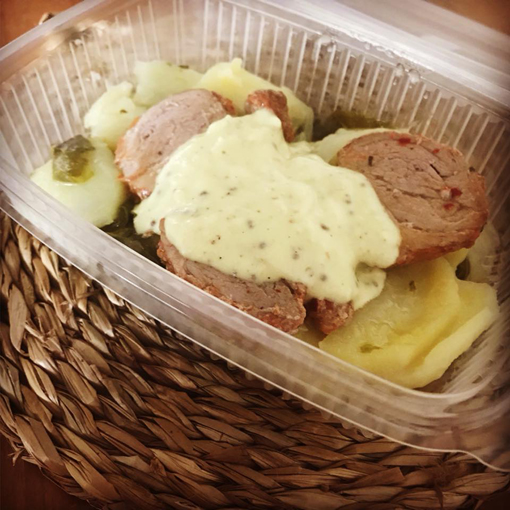
Solomillo a la mostaza con patatas hervidas =Sirloin with mustard and boiled potatoes
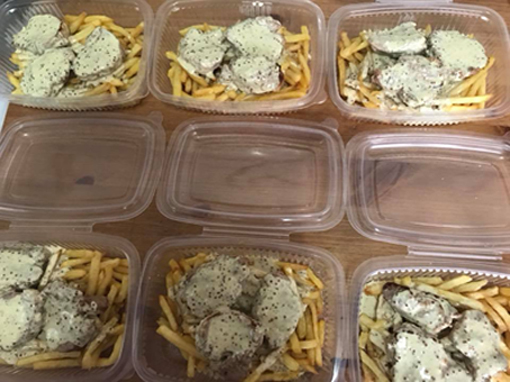
Solomillo con salsa de mostaza con patatas fritas = Sirloin with mustard and chips
I wanted to talk to you about this project, because Marian is alone and I think she deserves a little help --especially after having suffered a robbery by 2 deliverymen, whom she took on the company--. Therefore, I hope that you will like this article and hope that you can use this service, if you live in Malaga and tell it your friends --or maybe you want to create a company like this, if you live in another city--.
Until my next post, kind regards,
Luis.
Sponsored by Costaluz Lawyers.
Please click below:

 0
Like
Published at 11:17 AM Comments (0)
0
Like
Published at 11:17 AM Comments (0)
Another Spanish saying and proverb 80
Monday, February 19, 2018
Today I would like to talk to you about a very popular saying in Spain: "Caer del burro". It should literally be: “To fall down from a donkey”.
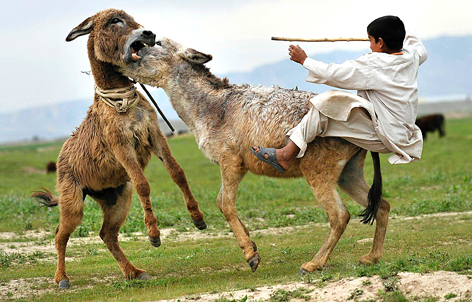
This expression means to recognise the mistake or stubbornness, maintained for a long time.
According to the Historian, Covarrubias, formerly it was said "to fall from its female donkey", that is to say "to disabuse itself of its erroneous opinion with the bad event".
The origin of this expression is probably in the fame that donkey has of being an awkward and a stubborn animal. But also it can be related to some anecdote, carried out by this animal with some person to whom it transported.
But apart from the symbolism of donkey, this phrase is a more popular and graphic version of a very similar one, which is "Caerse del caballo" (“Falling down from a horse”). And that refers to the well-known story of Paul of Tarsus --or Saint Paul--, who was Jewish and was sent to Damascus, to persecute the Christians, of whom it seems that he was very enemy. On the road to Damascus he fell off the horse, and the miraculous versions said that it happened because horseman and horse were blinded by a divine light. The truth is that the story says that, when he left the commotion, he left his attitude, converted to Christianity and became the most active apostle and diffuser of his faith of his time.
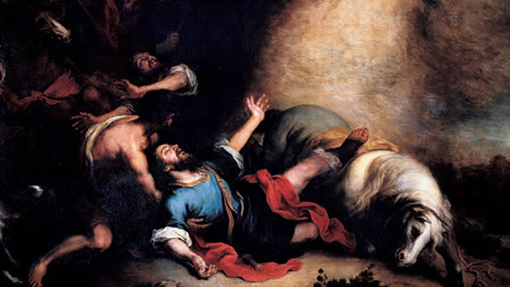
The conversion of Paul of Tarsus
Once I have also heard this expression in the case that someone speaks badly of another person and then it is said that the first one "puts down from a donkey" to the second one; but I do not know if this meaning is correct.
Anyway, maybe you did not know any of these versions and I hope that you will like this article.
Until my next post, kind regards,
Luis.
Sponsored by Costaluz Lawyers.
Please click below:

 0
Like
Published at 9:36 AM Comments (0)
0
Like
Published at 9:36 AM Comments (0)
Another abandoned small village in the north east of Spain
Wednesday, February 14, 2018
In the northeast of Spain, you can find a very small abandoned village, called Gallicant, which is a borough of Arbolí --although it belongs ecclesiastically to Siurana--.
 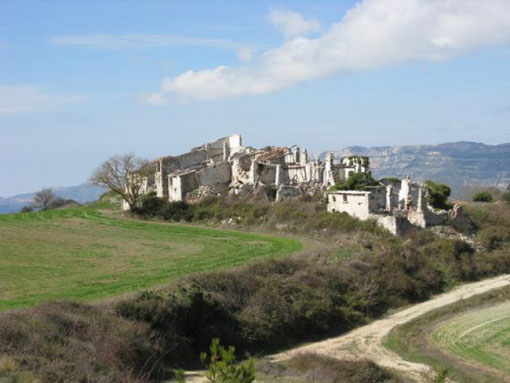
Arriving to Gallicant
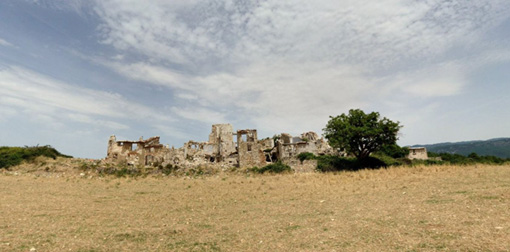
Another view of Gallicant
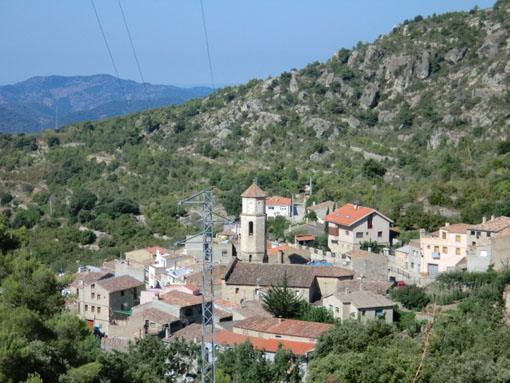
Arbolí
Gallicant is 880 metres above sea level, on a landing, with its back to the canyon, where the river Siurana moves, and facing the Puig de Gallicant.
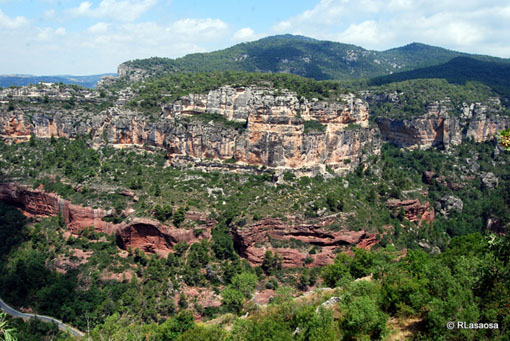
The canyon near the Siurana river
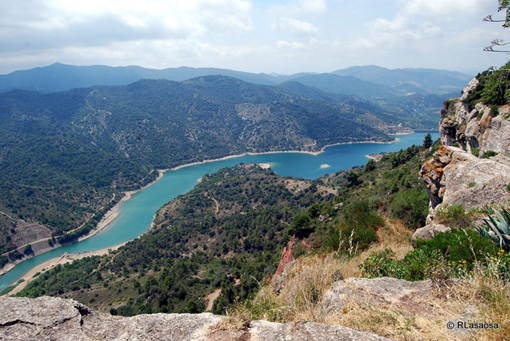
Siurana river
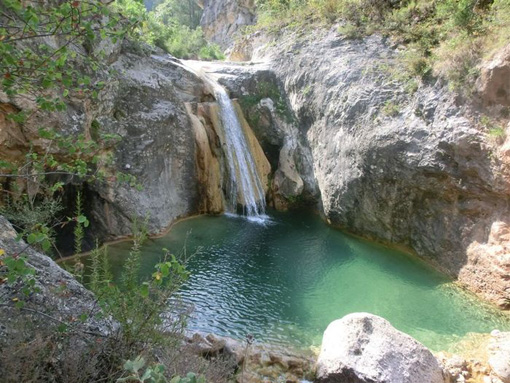
A pool of the Siurana river
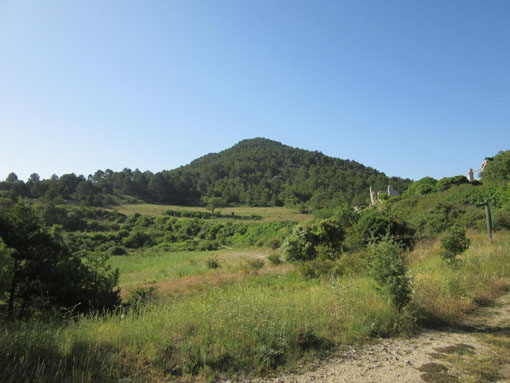
Puig de Gallicant
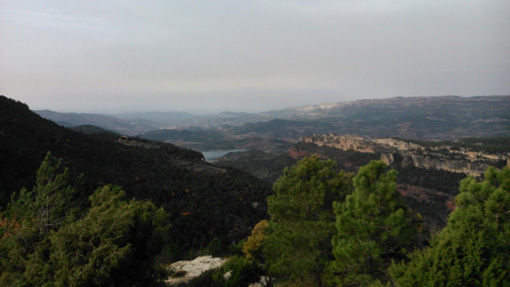
The swamp Siurana at the bottom
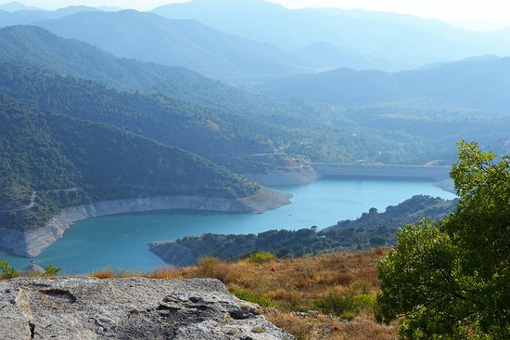
The swamp of the Siurana river
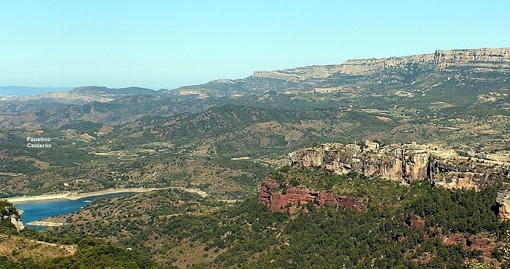
The swamp on the left side and Siurana on the right one and the Sierra of Montsant
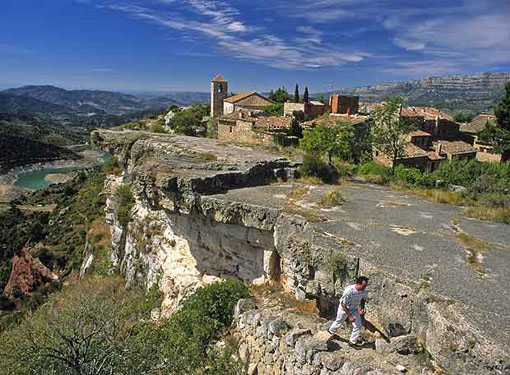
Siurana village
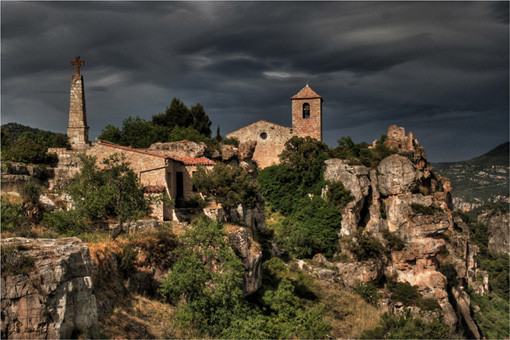
Siurana close up
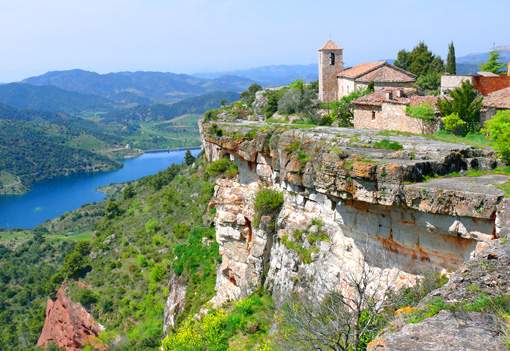
Some cottages in Siurana
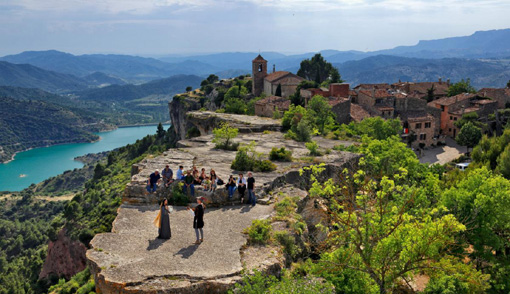
Guided visits to Siurana
When you arrive to Gallicant, you can see this:
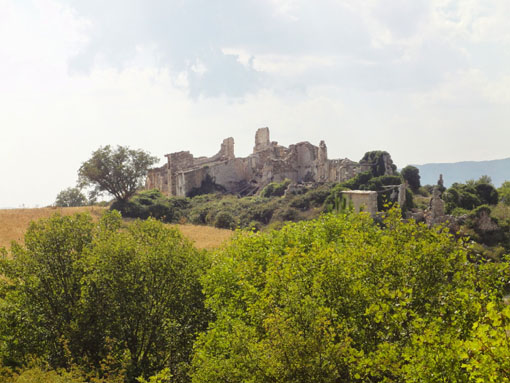
Gallicant close up
Gallicant was composed of 8 houses; but nowadays, they are all without a roof, without interior beams or partitions. Two of those houses were: Cal Salvador Manuel and Cal Matillo.
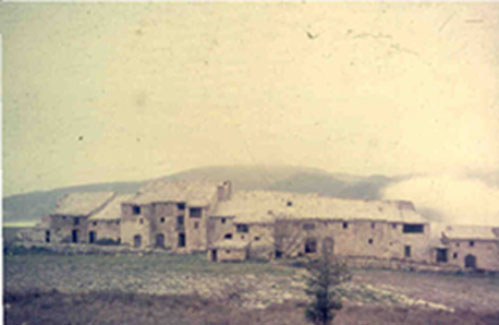
The houses while the neighbours lived there, in 1965
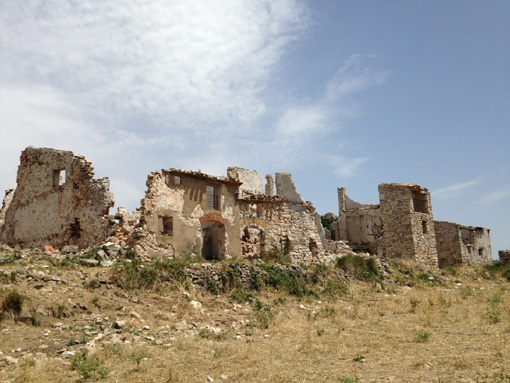
Cal Salvador Manuel and Cal Matillo on the left side
The hardness of the land and lack of services caused that several houses were closed, in the 30s and 40s, even when they kept the house in use, in the high season of agricultural work.
They went down to live in Arbolí and, from there, they went up to perform the tasks of the field.
Wheat, oats, rye and chickpeas were what was grown, in their farms, also having vineyards, in the flatter areas of lower height.
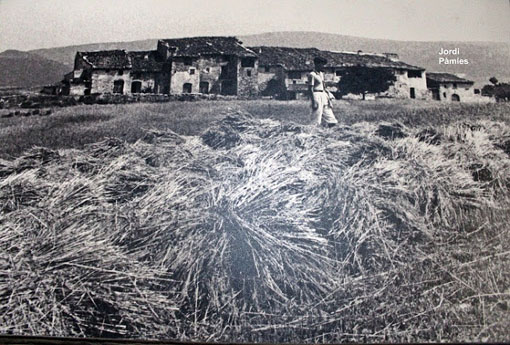
Sheaf of stalk in 1930
Cal Casat, Cal Manuel, Cal Joanet and Ca l'Anyep were the houses that had press, to make wine. They also made a variety of aguardiente, which they sold to Reus, and the same village, where they went down to sell the surplus of agricultural products.
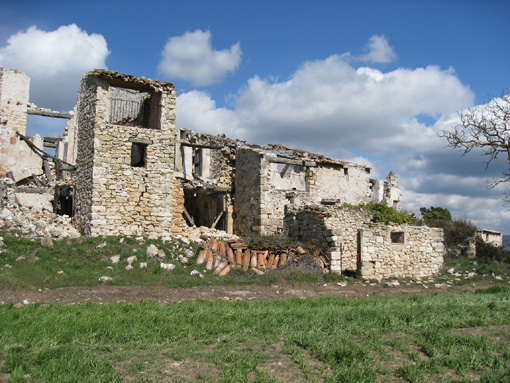
The house named Cal casat with a balcony on the left side and other houses
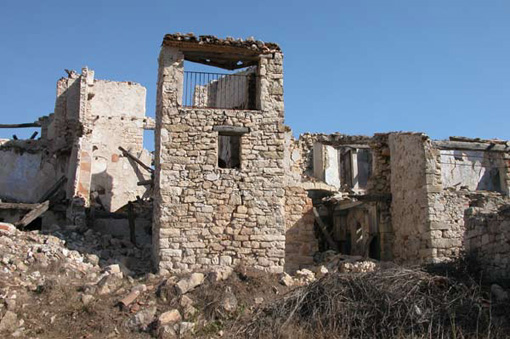
Cal Casat
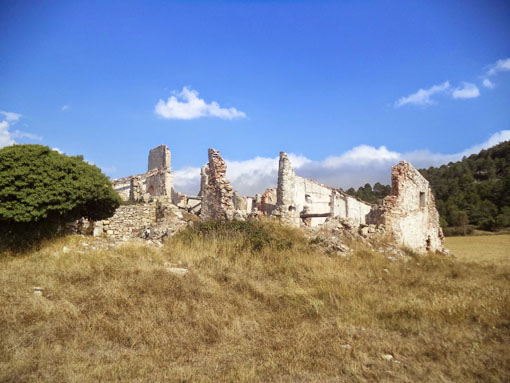
Cal Estudiant
Each house had its oven, to make bread.
The electric light never came to Gallicant. The oil and carbide lamps were his source of illumination.
One of the main problems, that Gallicant had, was the water. They made a deposit, next to the houses, to channel the water, from a fountain, but, in time of drought, it was scarce and they had to go and look for it 15 minutes from the village. Cal Casat and Cal Joanet built two wells, to collect rainwater and thus alleviate its shortage.
The doctor went to Gallicant on rare occasions.
There was no postal service and it was any neighbor, who went down to Arbolí and took the letters to Gallicant.
The creation, in 1950, of the military camp of Los Castillejos, 3 kilometres from Gallicant, supposed a slight rise of all the surrounding villages.
Although Gallicant was already demographically agonizing, the search for leisure and spending free time (Saturdays and Sundays) of the soldiers, who did not go down to the places closest to the coast, caused several of these groups to visit the village frequently. So, the soldiers ordered meals and asked them to wash their clothes, in some houses. All this allowed Gallicant not to be an uninhabited village.
Life was complicated in Gallicant.
In the end, all the neighbours went to Arbolí, Alforja, Reus and Vilaplana.
Joan Juncosa and Dolors Nadal, with three children, who were living with them, were the last of Gallicant. They closed Cal Joanet, in the early 60's and went down to the village of Arbolí.

Cal Joanet, the last abandoned house in Gallicant
Well, I hope that you will like this article.
Until my next post, kind regards,
Luis.
Sponsored by Costaluz Lawyers.
Please click below:

 3
Like
Published at 11:44 AM Comments (1)
3
Like
Published at 11:44 AM Comments (1)
Talking about tools in the northeast of Spain
Friday, February 2, 2018
Last Sunday, the radio program, "No es un día cualquiera", was held in Logroño (La Rioja, northeastern Spain), and within the program, the Latin teacher, Emilio del Rio, spoke on the word "Tool", because, in La Rioja, there is the WURTH company, which sells tools.
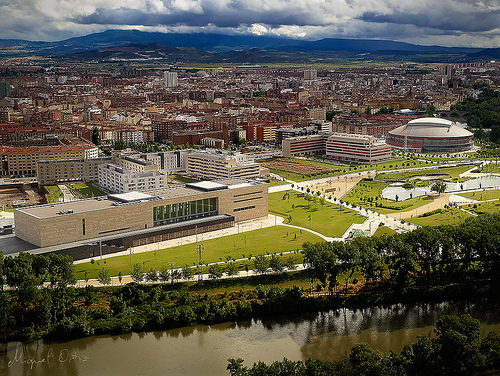
A view of Logroño
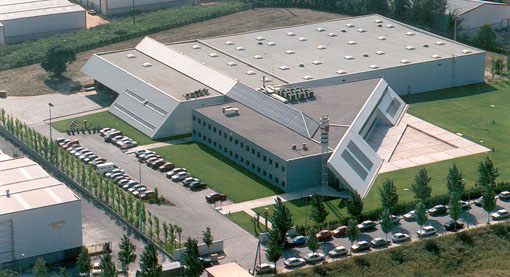
The WURTH company
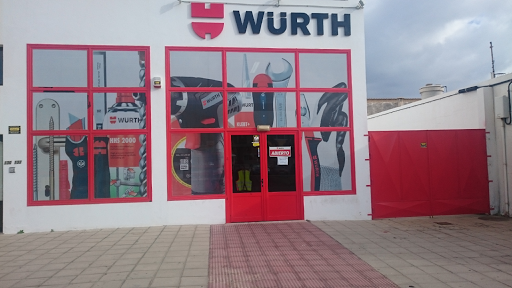
Wurth in Canary Islands
The word “Tool” has several synonyms: useful, utensil, instrument, apparatus, gadget, implement.
Why did Emilio del Rio talk about the tools?, but because he says that we still use the same tools that the Romans used (they used hammers, screws, pliers, scissors, files --or rasps--, saws ...). And Emilio del Rio says that these are called tools because they are made of iron. There were also tools made of copper, bronze, wood; but, etymologically, a tool is made of iron. "Tool" comes from "Ferramenta, Ferramentum, Ferramenta" --which comes from "Ferrum" plus the suffix "mentum", which is used to form nouns--. And what result does "Ferrum" give in Spanish?, then "Hierro" --the "F" becomes "H", as it happens with "Cante jondo", which really is "Cante hondo" -.
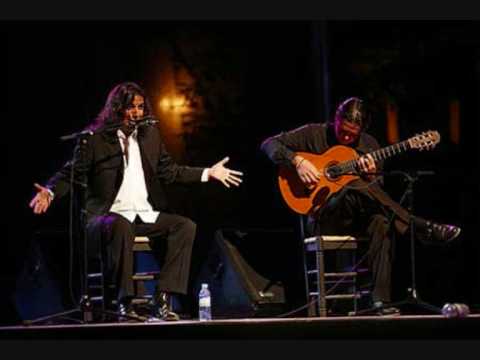
Manuel Machado singing Cante Hondo
The one who makes the tools is the Blacksmith --the one who works iron-- . Those who work with tools have a Pattern (Vulcano, who is the "blacksmith God" of Classical Mythology, who worked metals and metallurgy. Vulcano had his forge, that is his factory, on a volcano (Etna) --by the way: there is a famous painting, by Velázquez, entitled "The forge of Vulcano"--.
 by Diego Velázquez a 4,3 cm.jpg)
La Fragua de Vulcano (the Forge of Vulcano) by Diego Velázquez
Another word, related to tool, is: "Horseshoe" (the iron that is put on the hoof of the horse). It is called a horseshoe, because, originally, it was made of iron.
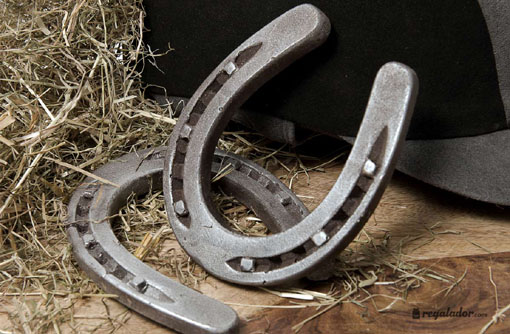
Two horseshoes
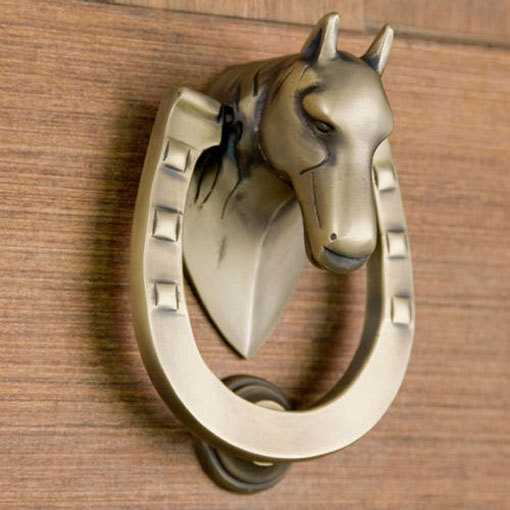
A horseshoe around the head of a horse
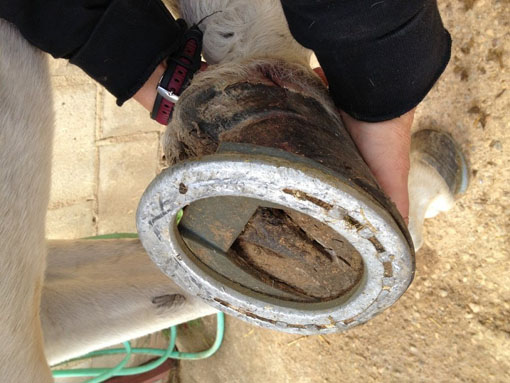
A horseshoe on a hoof of a horse
The tools are bought in the "DIY shop". DIY shop also comes from "Ferrum". Literally, DIY shop is the shop where iron is sold. And the company WURTH, in reality is a large home delivery DIY shop.
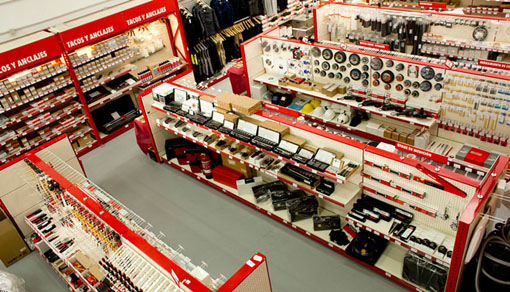
A DIY shop of Wurth inside

A toolbox by WURTH

Another types of tools
The primitive form "Ferrum" is the chemical symbol "Fe".
When something is hard and tenacious, we say that it is "férreo" (“fierce”), which means "iron" - and, since iron is so resistant, hence is where the expression comes from, which means "hard, tenacious" -. For example, in football, we say: "This team practices a fierce defense".
When someone holds on to something with force, we say that person "grips" --literally, it means that "it is held with irons"--.
Another word, which comes from iron, is "Ferrocarril" (Railway) – it is literally "Carro de hierro" (Carriage of iron). First it refers to the road (Lane); but it also refers to the train. According to the Royal Academy of the Spanish Language, it is "A road, with two parallel iron lanes, on which trains roll".
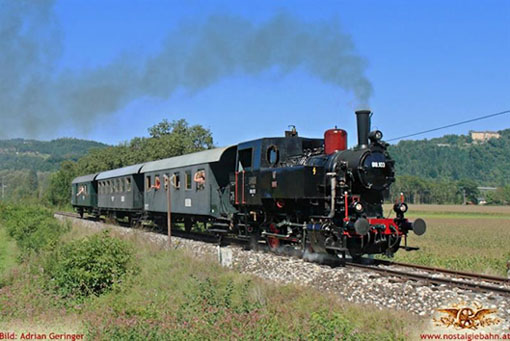
Railway

Two parallel rails
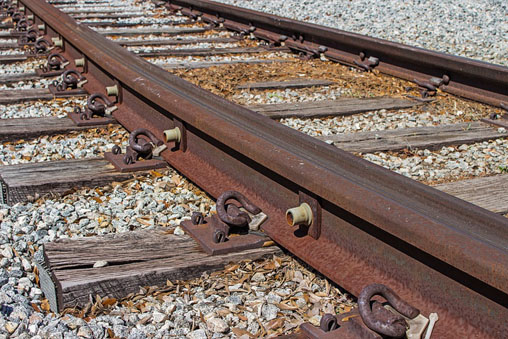
Rails made of iron
The Romans carried the tools by carriage, but not by railway.
Well, as the teacher, Emilio del Rio, should say: “Tempus fugit”, ie: “Time is over” or "Time is flying".
I hope that you will like this article.
Until my next post, kind regards,
Luis.
Sponsored by Costaluz Lawyers.
Please click below:

 0
Like
Published at 8:07 PM Comments (2)
0
Like
Published at 8:07 PM Comments (2)
Spam post or Abuse? Please let us know
|
|